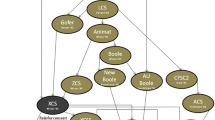Abstract
This paper introduces a new variety of learning classifier system (LCS), called MILCS, which utilizes mutual information as fitness feedback. Unlike most LCSs, MILCS is specifically designed for supervised learning. We present experimental results, and contrast them to results from XCS, UCS, GAssist, BioHEL, C4.5 and Naïve Bayes. We discuss the explanatory power of the resulting rule sets. MILCS is also shown to promote the discovery of default hierarchies, an important advantage of LCSs. Final comments include future directions for this research, including investigations in neural networks and other systems.














Similar content being viewed by others
Notes
The prime of [P′] indicates the population set with one particular rule removed. Same applies to [M′] and [~M′]. However, these sets are not shown in Fig. 3.
References
Bacardit J (2004) Pittsburgh genetics-based machine learning in the data mining era: representations, generalization, and run-time, PhD thesis, Ramon Llull University, Barcelona, Catalonia, Spain
Bacardit J (2007) Personal communication
Bacardit J, Stout M, Hirst JD, Sastry K, Llorà X, Krasnogor N (2007) Automated alphabet reduction method with evolutionary algorithms for protein structure prediction. In: Proceedings of the 9th annual conference on genetic and evolutionary computation (GECCO2007), ACM Press, pp 346–353
Bernadó-Mansilla E (2003) Accuracy-based learning classifier systems: models, analysis and applications to classification tasks. Evol Comput 11(3):209–238
Bull L (2009) Personal communication
Butz MV (2003) Documentation of XCS+TS C-Code 1.2, IlliGAL report 2003023, University of Illinois at Urbana-Champaign, (Source code: ftp://gal2.ge.uiuc.edu/pub/src/XCS/XCS1.2.tar.Z)
Butz M, Wilson SW (2001) An algorithmic description of XCS. In: Lanzi PL, Stolzmann W, Wilson SM (eds) Revised papers from the third international workshop on advances in learning classifier systems. Lecture notes in computer science, 1996. Springer, London, pp 253–272
Fahlman SE, Lebiere C (1990) The cascade-correlation learning algorithm. In: Advances in neural information processing systems, vol 2. Morgan Kaufmann, pp 525–532
Goldberg DE (1989) Genetic algorithms in search, optimization and machine learning. Addison-Wesley, Boston
Heckerman H (1996) A tutorial on learning with bayesian networks, Technical Report, MSR-TR-95-06
Holland JH (1992) Adaptation in natural and artificial systems, 2nd edn. MIT Press, Cambridge
Holland J, Holyoak KJ, Nisbett RE, Thagard P (1986) Induction: processes of inference learning and discover. MIT Press, Cambridge
Kovacs T (2000) Strength or accuracy? Fitness calculation in learning classifier systems, learning classifier systems: an introduction to contemporary research. Springer, Berlin, pp 143–160
Kovacs T, Kerber M (2001) What makes a problem hard for XCS? In: Lanzi P, Stolzmann W, Wilson S (eds) Advances in learning classifer systems: proceedings of the third international workshop, volume 1996 of lecture notes in artificial intelligence. Springer, Berlin, pp 80–99
Jiang MK (2009) MILCS: a mutual information based learning classifier system, PhD thesis, University College London, UK
Langley P, Iba W, Thompson K (1992) An analysis of bayesian classifiers. In: Proceedings of the tenth national conference on artificial intelligence, AAAI Press, pp 223–228
Lanzi PL, Loiacono D, Wilson SW, Goldberg DE (2005) XCS with computed prediction for the learning of boolean functions. Evol Comput 1:588–595
Orriols-Puig A (2008) Personal communication
Quinlan JR (1993) C4.5: programs for machine learning. Morgan Kaufmann, San Mateo
Shannon CE (1948) A mathematical theory of communication. Bell Syst Tech J 27:379–423 (623–656)
Shannon CE (1949) Communication in the presence of noise. In: Proceedings of institute of radio engineers, vol 37, no. 1, pp 10–21
Smith RE (1991) Default hierarchy formation and memory exploitation in learning classifier systems, PhD thesis, The University of Alabama, USA
Smith RE, Behzadan B (2008) Mutual information neuro-evolutionary system (MINES), IEEE Congress on Evolutionary Computation (CEC) 2009, pp 1523–1529
Smith RE, Cribbs HB (1994) Is a classifier system a type of neural network? Evol Comput 2(1):19–36
Smith RE, Jiang MK (2007) A learning classifier system with mutual-information-based fitness. In: Proceedings of the 2007 congress on evolutionary computation, pp 2173–2180
Stout M, Bacardit J, Hirst JD, Krasnogor N (2006) From HP lattice models to real proteins: coordination number prediction using learning classifier systems. In: Proceedings of the 4th European workshop on evolutionary computation and machine learning in bioinformatics. Lectures notes in computer science, 3907, Budapest, Hungary, pp 208–220
Stout M, Bacardit J, Hirst JD, Smith RE, Krasnogor N (2008) Prediction of topological contacts in proteins using learning classifier systems. J Soft Comput Fusion Found, Methodol and Appl 13(3):245–258
Stubbs N, Park S (1996) Optimal sensor placement for mode shapes via Shannon.s sampling theorem. Microcomput Civ Eng 11:411–419
Sutton RS, Barto AG (1998) Reinforcement learning: an introduction. MIT Press, Cambridge
Wilson SW (1995) Classifier fitness based on accuracy. Evol Comput 3(2):149–175
Wilson SW (1998) Generalization in the XCS classifier system. In: Koza JR, Banzhaf W, Chellapilla K, Deb K, Dorigo M, Fogel DB, Garzon MH, Goldberg DE, Iba H, Riolo R (eds). Genetic programming 1998: proceedings of the third annual conference, Morgan Kaufmann, pp 665–674
Wilson SW (2001) Function approximation with a classifier system. In: Spector L et al. (eds) Proceedings of the genetic and evolutionary computation conference (GECCO-2001), Morgan Kaufmann, San Francisco, CA, pp 974–981
Acknowledgments
The authors greatly acknowledge support provided by the UK Engineering and Physical Sciences Research Council (EPSRC) under grant GR/T07541/01 & GR/T07534/01.
Author information
Authors and Affiliations
Corresponding author
Rights and permissions
About this article
Cite this article
Smith, R.E., Jiang, M.K., Bacardit, J. et al. A learning classifier system with mutual-information-based fitness. Evol. Intel. 3, 31–50 (2010). https://doi.org/10.1007/s12065-010-0037-9
Received:
Revised:
Accepted:
Published:
Issue Date:
DOI: https://doi.org/10.1007/s12065-010-0037-9




